Granville War Memorial
Maryborough, Queensland, Australia
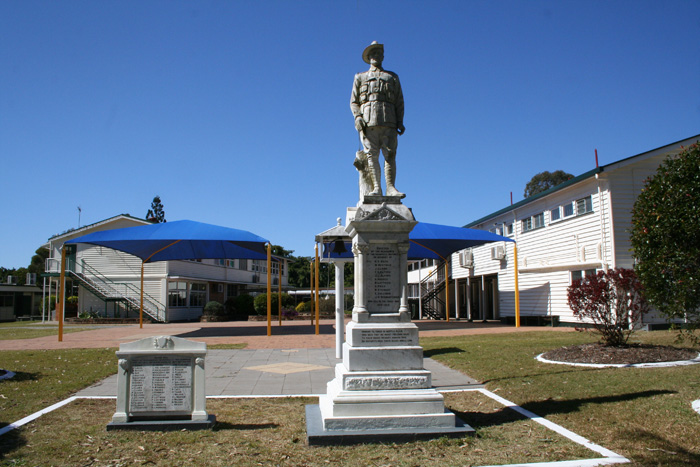 |
|---|
| The Granville War Memorial - with Granville State School in the background, and the names of the soldiers enlisted are on the Honour Stone to the left. |
In many towns, suburbs and cities of Australia, individual public monuments and memorials have been used to commemorate more than one conflict that Australians have been involved in. This War Memorial is a tribute to local men from Granville, now a suburb of Maryborough, Queensland, Australia - who fought and died in the First World War. The Granville War Memorial has outstanding significance for its splendid and intact setting and as an historical record of local participation and sacrifice in two World Wars.
By Dr Richard Walding - Research Fellow, Griffith University, Australia
Email: waldingr49@yahoo.com.au
HISTORY OF THE WAR MEMORIAL
The War Memorial stands in the grounds of the Granville State School, in Cambridge Street. It is at the western boundary and looks down over the farmlands beside the Mary River.
The school held a fete on Saturday 20th March 1920 to raise money for the memorial. A good start was made to the £200 required with a taking of £85. This enabled the war memorial committee to erect an Honour Stone in the school grounds the following month which recorded the names of those soldiers from the area who enlisted in WW1. As with all Queensland war memorials and honour boards, the names are not exhaustive and comprise soldiers who do live in the area but also many who grew up there, have parents or relatives there, or have nominated a next-of-kin. The names are proposed by such people, or by the returned soldiers themselves, and, as such, are not complete. A good example is for Pte Robert Stewart (716) who had never been to Maryborough but his sister Catherine (next-of-kin) lived in Wharf Street Maryborough at the time of his death in June 1917.
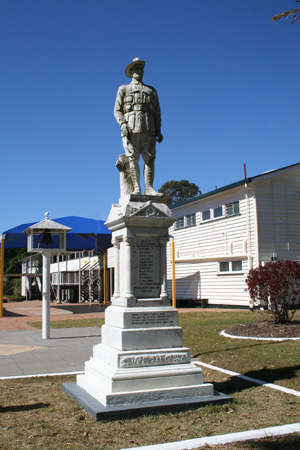 |
|---|
During the remainer of the year more money was collected and a soldier-statue was was procured for the Granville community by Mr Frederick William Webb, a well known Maryborough monumental mason. It was made in Sydney for the cost of £392. The Granville War Memorial was officially unveiled on Sunday 3 April 1921 by the Minister for Public Instruction, the Hon. J. Huxham. In speaking to the large crowd, he said that he had given permission for the memorial to be erected in school grounds (despite dissent) on the promise that "every child attending the school would see it and become acquainted with the names of their soldier forefathers and their deeds of bravery." He made the point that of the 52 local men who had enlisted, 11 had made the supreme sacrifice. Also addressing the audience were Cr Henry Bashford (of the Burrum Shire, who presided), the Maryborough Mayor (Alderman Issac 'Ike' Bushnell), Councillor Edward James Stafford (Chairman of the Burrum Shire Council), Mr Edward James Hatton (president of the Maryborough sub-branch, R.S.S.I.L.A), Mr G. Armitage (vice-president of the Fathers' Association), and Councillor T. W. Wilson.
The school's principal, Mr J Lennon organised the pupils to plant eleven garden beds around the memorial each representing one of the fallen soldiers, with their initials inscribed in a floral design. My father Robert was a student there at this time and participated in Anzac Day services around the memorial.
THE MONUMENT
All stone memorial soldiers in Queensland are infantrymen - like our Granville soldier - in full marching kit and no backpack. Notice that he is wearing a slouch hat and not a cap as was worn just as often. This adds to the Australian identity of the "Digger". The rifle (a Lee-Enfield .303 calibre) was destroyed by vandals. I am told by Ross Sharpe - Granville State School teacher and local historian - that it is soon to be replaced.
Like most all of the soldier statues in Queensland (61 of them) there is no mention of rank on the Granville Monument. In Queensland there is just the one monument that orders the soldiers in terms of rank; and another seven in which rank is listed but not ordered. The Granville list of fallen soldiers typifies the idea that communities had - that the men were buried as equals, officers and men alike. The stone digger was without rank or social class.
The Granville monument stands 4.3 m high. The pedastal, at 2.56 m high, is surmounted by a life-sized figure of an Australian soldier standing at ease. He is approximately 168 cm (5' 6") tall. Queensland stone soldiers are all between 5 ft and 5' 6" tall so he is at the upper end in height. They were to typify the common Digger but the statues were less than the average height of 'real' soldiers of 1915 which was 5' 6". My thanks to Ross Sharpe for help with the Granville dimensions.
Like the Granville soldier, many of Queensland soldier statues stand in a relaxed pose - with feet apart, head erect, rifle pointing upwards. The soldier at the Beaudesert memorial is a good example of an even more relaxed soldier - tunic unloosened, pipe in hand, rifle slung casually from his left shoulder. The Atherton soldier is advancing aggressively, rifle in hand, tin helmet and gas mask - a man from the trenches - in action. The most common pose for a soldier statue is standing in an attitude of mourning; head bowed; rifle reversed and resting on the left boot. This is how the soldier is shown at the Manly War Memorial in suburban Brisbane (click link to see my webpage). The "Rest on Arms Reverse" position is quite common throughout Australian memorials and denotes that the persons names on the monument have "fallen" (died in war). It is the prescribed position in drill manuals for catafalque parties standing vigil at funerals and at Anzac Days.
THE INSCRIPTION
 |
Inscription on the War Memorial |
Queenslanders, like all Australians, in the years soon after WW1 felt an obligation to pay tribute to their fallen but not all chose an inscription and left the invocations unsaid. Those that did - like the residents of Granville chose the moving words above. Others, like the residents of the Brisbane suburb of Yeronga - chose the classic statement "In appreciation of our boys who sacrificed their lives in the Great War 1914-1919" for the Yeronga Cenotaph. Yet others would have a simple "In Memoriam" or use a combination of words like "appreciation", "homage", "tribute" and "gratitude". Some would have a Christian statement about vicarious death taken from St John's Gospel, Chapter 15, Verse 13: "Greater love hath no man than this, that a man lay down his life for his friends".
The most popular invocation was from the Apocrypha by Rudyard Kipling "Their name liveth for evermore". After WW2 "Lest we Forget", taken from Kipling's Recessional, was to prove the most popular thereafter. It is not certain where the Granville invocation originated. It appears at other WW1 memorials in Australia.
THE FALLEN SOLDIERS
 |
|---|
| The names of the 12 fallen soldiers. |
Surname
| First Name/s |
Reg. No. |
Reg. |
Date Died |
Age |
Location |
Back |
Herbert Stanley |
406 |
15 Bn |
8 Aug 1915 |
22 |
KIA Gallipoli |
Bentham |
William |
1905 |
41 Bn |
5 Oct 1917 |
27 |
KIA Belgium |
Clark |
James |
706A |
9 Bn |
11 Aug 1918 |
19 |
KIA France |
Elford |
Francis Granville |
6010 |
15 Bn |
29 Apr 1917 |
21 |
DOW Belgium |
Elford |
James Johnson |
1666 |
25 Bn |
5 Aug 1916 |
26 |
KIA France |
Hughes |
George Henry |
3819 |
2nd Pioneer Bn |
9 Sep 1917 |
29 |
DOW Belgium |
Leftwich |
Robert |
1989 |
47 Bn |
11 Apr 1917 |
22 |
DOI France |
Price |
John Griffith |
4639 |
47 Bn |
11 Apr1917 |
25 |
KIA France |
Stewart |
Robert |
716 |
42 Bn |
29 June 1917 |
29 |
KIA Belgium |
Sullivan |
Charles William |
752 |
30 Bn |
16 Oct 1916 |
28 |
DOW France |
Schwarzrock |
Johann Otto |
6415 |
26 Bn |
4 Oct 1917 |
30 |
KIA Belgium |
KIA = Killed in Action; DOW = Died of Wounds
BIOGRAPHICAL DETAILS OF THE FALLEN SOLDIERS
The images are photographs of the name plaque on the memorial.
 |
|---|
HERBERT STANLEY BACK |
The couple subsequently had Ethel in 1895, Teresa (1897) and Reginald (1899). All children attended East Maryborough State School - later to be called Granville State School. Bert Back's school enrolment began on 31 August 1898 just as he was about to turn 5 years old.
When the Great War started in 1914, Bert was working as a bottler in Maryborough and immediately decided to join the army. His brother Frederick Ernest, a 24-year-old boilermaker working at Walker's Ltd Maryborough, had already enlisted on 19 August - and now it was Bert's turn to go. Their father, Frederick, said "I did my damndest to stop Bert but he was too strong-headed". However, their father did persuade his other son Arthur from joining up. Bert enlisted in the army six weeks later. On 17 September 1914, at the age of 21, Bert joined the newly raised 15th (Infantry) Battalion AIF. Three-quarters of the battalion were recruited as volunteers from Queensland, and the rest from Tasmania. With the 13th, 14th and 16th Battalions it formed the 4th Brigade, commanded by Colonel John Monash. His brother Frederick had already left for overseas on HMAT Omrah by this stage.
After some initial training in Brisbane, Bert travelled by train to Victoria where the four battalions began training. The Brigade embarked aboard HMAT A40 Ceramic for overseas just before Christmas. After a brief stop in Albany, Western Australia, they proceeded to Egypt, arriving in early February 1915. Australia already had an AIF division there, the 1st. When the 4th Brigade arrived in Egypt, it became part of the New Zealand and Australian Division. For the next two months they trained in preparation for what they thought was the war on the western front in France. The 15th Battalion left Alexandria on 12 April and headed for Turkey instead. They arrived at Mudros Harbour on the Greek island of Lemnos two days later. Here they practiced disembarking for the next 10 days.The 15th Battalion boarded the Seang Bee on the 25th April and headed for the Gallipoli Peninsula. They anchored off Anzac Cove at 4 pm that day. This was the first day of the Anzac arrivals at Gallipoli. The 15th were taken ashore by landing craft at 10.30 pm under heavy shrapnel bombardment from the Turkish soldiers. Four men were hit. The next day they took up cover positions and remained like this until the 30th when they moved to Monash Valley. Bert's unit - 'C' Coy under Captain Quinn - occupied Pope's Hill in the afternoon and were under immediate attack from Turkish machine gun fire. They then retired for bivouac in Monash Valley and then were back to Quinn's Hill for an attack on the 9th in which they sustained heavy casualties (160 killed or wounded) causing them to retire to bivouac on the 10th and then back again to Quinn's Post on the 12th where many more casualties were sustained that day (the morning of the 13th). Bert Back was wounded in the left shoulder and as he couldn't be accounted for was reported missing. He was soon found injured and reported 'wounded in action'. Bert was taken by ship back to the convalescent hospital in Mustapha in Egypt. His mother received a telegram on the 24th May to this effect. The following month he was discharged for duty and returned to Gallipoli on 26 June 1915.
For the rest of June the 15th Battalion were in bivouac at Walker's Gully but were shelled nevertheless. Most of July was spent in bivouac but in August the 15th Battalion moved back into action. During this time Bert was promoted to Lance Corporal (20 July). His brother Fred was also at Gallipoli. He was with the 5th Light Horse (dismounted) when, on 1 August 1915, an enemy shell struck his dugout. It dislodged several sandbags that landed on his legs and crushed both knees. Fred was taken to the hospital at Mudros and then to the Helouan Convalescent Hospital in Egypt. Here he was unable to flex his right leg and had grating on movement of his left. He was classed as medically unfit for service and recommended for returned to Australia and discharge.
On 6 August 1915 at Gallipoli, Bert's batallion - the 15th - left bivouac for Reserve Gully at 10.20 am and marched at 'double' along Beach Road where they sustained attack from an enemy trench position. A bayonet charge was made at the Turks and the enemy killed. At daylight on the 7th the enemy was in retreat. The 15th continued making progress on the 8th when an advance line of scouts from their battalion came into contact with a Turkish patrol. Gunfire was exchanged and then there was a heavy outburst from the Turks on the high slopes. The enemy was held at bay mostly by the forward troops of B Coy. C Company (including Bert) was sent to support them and headed for the NE spur but came under strong opposition and heavy casualties from the eight Turkish machine guns resulted. Bert was hit and killed during this time - possibly by gunfire, possibly by a shell. The rest of the battalion had to fall back as the attack was so severe. In fact, a general retreat of the whole Brigade was ordered.
During that skirmish the battalion lost 100 men killed, 188 wounded, and 103 wounded and missing. The following day - 9th August 1915 - a telegram was sent to Mrs Back at Granville notifying her of Bert's death. Bert Back was memorialised at the Lone Pine Memorial at Anzac Cove. His brother Frederick returned to Australia on 15 November that year with "synovitis" to both knees and discharged on 15 March 1916 with a pension of £3 per fortnight. Fred married in 1920 and died unexpectedly on 27 August 1924. It has long been claimed that Fred died as a result of war wounds. Father Frederick died on 24 February 1935, and his wife Teresa in 1956. Many descendants are alive today.
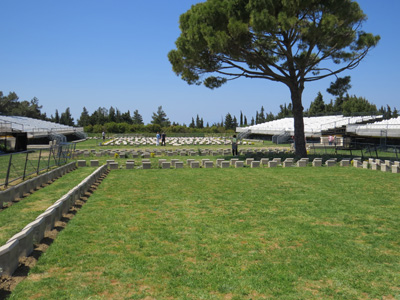 |
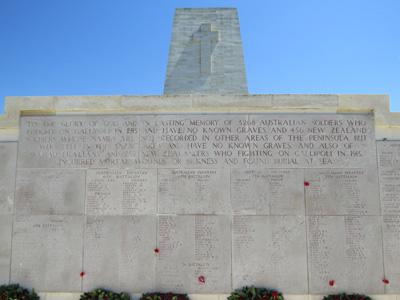 |
Lone Pine Cemetary, Gallipoli. (Jim Hawker 26 April 2013) |
On Anzac Day 2013, Jim Hawker, the Secretary of Stephen's RSL, visited Gallipoli. At my request he placed a poppy beside the name of Herbert Back in the memorial for the men with no known grave. It is the top right poppy.(Jim Hawker) |
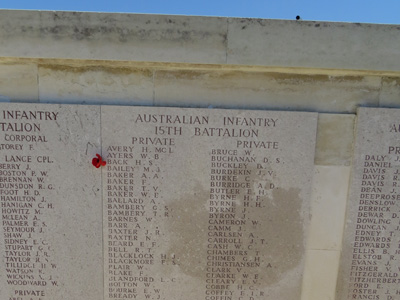 |
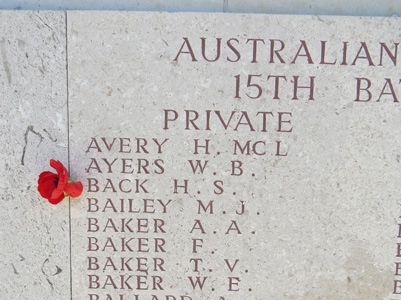 |
A close-up of Herbert Back's name on the memorial. |
 |
|---|
| JOHN OTTO SCHWARZROCK |
Johann (John) Otto Schwarzrock was born in Maryborough on 16 October 1887 to parents Gottfried and Wilhelmina Schwarzrock (nee Schnark).
His parents were both born in Germany (Prussia as it was then): his father, Gottfried, a farmer, was born in 1841 in the tiny Prussian (German) village of Liebwalde, in the county of Mohrungen. Today this town is known as Lubochowo in the county of Morag, in Poland, about 400km east of the German border. His mother Wilhelmina was born in 1850 in Koenigsberg (now Kalingrad, Russia) a town about 100 km to the NE of Liebwalde. They married in the nearby town of Blumenau, New Christburg (now Dzierzgoń, Poland) in 1878. The family emigrated to Australia - departing Plymouth, England, on 9 December 1882 aboard The Duke of Buckingham - and arrived in Maryborough in February 1883. They brought with them their children Marie (1), Caroline (6), Dorothea (8) and August (9). Another daughter - Anna Paulina - was born in Maryborough on 1 November 1885. John was born 2 years later.
The family lived at (Schwarzrock Road) Boonooroo, about 20km south west of Maryborough almost on the edge of the Great Sandy Strait. Here John's father Gottfried worked as a farmer while the boys John and Ernest worked as fishermen. It would seem that John became handy with farming machinery and boat engines, so much so that he could call himself a motor mechanic.
With the onset of the Great War in August 1914, the Australian Government introduced a plan to strengthen homeland security. In 1916 it required all 'aliens' (ie non-British subjects/foreign nationals living in Australia) to register with local authorities. Gottfried Schwarzrock registered on 21 October 1916 in Maryborough. It was not too intrusive a requirement, he merely had to state his physical wherebaouts in Australia, the ship and date of his arrival, date and place of birth, occupation, marital status, and a physical description. John was born in Australia so he didn't need to register; in fact he decided to enlist in the war that would see him fighting soldiers from his father's homeland.
At the age of 29, on 13 November 1916 John enlisted in the AIF in Maryborough and named his good friend William Zebrovius from Boonooroo as his next of kin. John was then sent to Brisbane to train with the 11th Depot Battalion. He had already served in the Rifle Club Reserves of the Citizens Forces. At the end of the month he was transferred to the 26th (Infantry) Battallion. Two weeks later - 14 December 1916 - John married 21-year-old Daisy May Skiffins. He made out a will in Brisbane naming Daisy as beneficiary but noted that should she predecease him, his good friend William Zebrovius would revert to being next of kin.
The 26th Battalion was raised at Enoggera, Queensland, in April 1915 from recruits enlisted in Queensland and Tasmania, and formed part of the 7th Brigade. The original battalion left Australia in July 1915, and served at Gallipoli and then proceeded to France as part of the 2nd Australian Division in March 1916. They fought a major battle around Pozieres in August then after a short spell in Belgium, they came south in October to attack again in the Somme Valley. John left Australia aboard A64 Demosthenes on 22 December 1916 and arrived in Plymouth, England on 3 March 1917. This is the port that his family emigrated to Australia from in 1883.
John trained in England for a few months and left for France arriving in Havre on 20 June. He proceeded north and joined the 26th Battalion on the 9th July. John didn't know it at the time but his father Gottfried Schwarzrock died in Maryborough that very same day. They were training in Bapaume in northern France and continued to do so for the remainer of the month. On the 28th July the 7th Brigade began a march 100km north to the town of French town of Renescure about 20 km from the Belgian border. Over the next few weeks they continued training and marching, ending up 20 km east at Steenvoorde almost on the Belgian border. From here they marched to the now-famous town of Ypres in Belgium where they joined the front line and had a successful attack, with few casualties and lots of prisoners.
At the start of October 1917 the Brigade marched further in to Belgium - another 10 km east to Zonnebeke. Just after midnight on the 4th October the 26th Battalion (including John) "jumped off" and proceeded to the right side of St Joseph's Ridge. There was intermittent shelling from the Germans until 5.30 am when the Germans put down a deep and heavy barrage of bombs in preparation for an assault but were countered by return barrages from the Australians. The German assault never eventuated. Nevertheless, the enemy inflicted a fair number of casualties.
At dawn the Australian artillery began a furious barrage against the Germans in preparation for their own assault on the nearby Broodseinde Ridge. A 3 minute Australian artillery barrage 150 yds ahead of the 26th Battalion allowed them to begin their advance. This creeping barrage advanced another 400 yards in the next 15 minutes with the 26th Battalion advancing behind it over extraordinarily difficult country. The 26th took their objective - the so-called "Blue Line". The casualties were heavy. John Schwarzrock was wounded by shrapnel from a German shell as he was advancing. His mate Pte Charles Tee - with whom he'd been since leaving Australia - saw John get hit in the thigh. He was able to walk with help and began to make his way back to the Casualty Dressing Station behind their "jumping-off" point. However, the Dressing Station scored a direct hit by a German shell and John was killed instantly. Because of the maimed bodies it seems he was not identified and was buried at what the Australians called San-Sousi Ridge. The 7th Brigade went on to capture Broodseinde Ridge later that day. The casualties for the day's battle were 63 killed, 393 wounded, 9 missing.
The army didn't identify John at the time and he was listed as "wounded in action" (WIA). They sent his wife Daisy a telegram on 24 October to that effect. The next day she wrote back to the army asking which hospital he was in. The army was unable to locate John in any hospital and on 3 December 1917 posted him as "wounded and missing". On 28 February the following year the army wrote to Daisy saying that they had no further news since posting him wounded and missing and asked if she had heard from him or anyone who knew of him. The same day she replied saying that she knew nothing at all. On 14th May 1918 she wrote again asking if there was any more news. Finally, the army convened a Court of Enquiry and on 15 April 1918 concluded that he was "Killed in Action". They wrote to Daisy on the 25th May advising that John was dead.
In September that year, John's widow Daisy married Waldeman Lloyd and she became Mrs Daisy May Lloyd. The Red Cross continued to search for John just in case he was taken prisoner. At the end of the war the army was to report that he was not to be found in Germany. He is memorialised at the Ypres (Menin Gate) Memorial, Belgium.
 |
|---|
GEORGE HENRY HUGHES |
George Henry Hughes was born in Emmaville, a small village on the Northern Tablelands of New South Wales. His parents were Arthur Valentine Hughes (b Grafton 1855) and Mary Josephine Hughes (nee Bentley, b 1856). They were married in Mackay, Queensland, in 1881 and had two children there: Amy and Alfred before shifting to Emmaville where George was born on 2 January 1886. He was followed by William Walter in 1892.
The family shifted to Granville the following year and continued their farming. Lily May was born in 1894, Charles Montease in December 1896 and Claude Wandsworth 1899. Here the school-aged children (William, Lily, Charles, Claude) were enrolled at Granville State School, including Ruby who was born in 1902. George spent some time at Appletree Creek State School at Childers. The family stayed in Granville until about 1910 and then shifted to a farm at Back Creek, Eukey, near Stanthorpe, about 400 km south, right on the Queensland/NSW border. In fact, it is only about 100 km north of Emmaville.
George enlisted in the army at Toowoomba on 7 September 1915. In fact, it was a family affair. Three brothers enlisted on the same day: George (age 27), William (23), and Charles (19) were all accepted into the AIF.
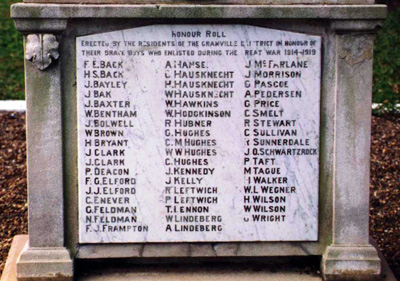 |
|---|
The Granville men who enlisted in WW1. The four Hughes brothers are visible in the middle. |
George was placed into C Coy 5 Depot Battalion for 3 months of training in Brisbane. He was transferred to the 9th Reinforcements 26th Battalion and departed Brisbane aboard HMAT Wandilla on 31 January 1916. Brothers William and Charles were training with the 5th Light Horse Regiment. About this time, their older brother Alfred Edward (31) enlisted. He was accepted on 1 February 1916 but a subsequent medical examination ruled him unfit. He had lost four toes from one foot in a grain screw conveyor accident at Mt Bauple in Queensland and the army discharged him on 3 March 1916. Alfred was married (to Jennie) and had three children to support anyway. The other brothers - William and Charles - left Sydney for Egypt on11 March 1916.
Upon arrival in Egypt, George was transferred to the newly formed 2nd Pioneer Battalion. This battalion was formed as a part of the second Division (as was his old 26 Bn). Their role was to undertake tasks in the forward area such as constructing trenches and dugouts although they occasionally acted in the engineer role on tasks such as construction of bridges. George departed Alexandria almost straight away and arrived in Marseilles on 26 March to joining fellow Anzacs in the British sector near Armentieres. The battalion began preparations for the planned British offensive on the Somme.
He became ill in May and had to be transferred to hospital in England for recovery. Nevertheless, he rejoined his Battalion in France on 25 August 1916. About another of the brothers enlisted in the AIF. Claude Wandsworth was just over 18 years old and enlisted in the 49th Bn on 1 August 1916 and sent to France.
The 2nd Australian Division was still in line in the Somme sector when George returned, preparing trenches for the final Australian attack of the Somme offensive.
On the 15th of April 1917 the 2nd Division was struck by a powerful German counterattack and on the 3rd of May the 2nd Pioneer Battalion was heavily engaged in the second battle at Bullecourt. It was here as Platoon leader for D Coy that George's bravery was recognised. His commanding officer, Lt Sydney Bede Chambers, recommended him for a Military Medal (but was knocked back).
By the start of September 1917 the Second Division were in Belgium undertaking exercises for the 'The Third Battle of Ypres', in particular what was to become known as the Battle of Menin Road. The 2nd Pioneer Battalion's task (as usual) was to prepare the front line trenches in readiness. On the 9th September George Hughes was leading his 15th Platoon of D Coy from the front line when a German plane dropped a Taube bomb that exploded next to him, penetrating his abdomen. A mate - Pte Thomas Leslie Munnings from the 13th Platoon was behind him and hit as well. Munnings was not badly wounded and help George back to the Casualty Dressing Station. From here he was ferried the 20 km west to the Field Ambulance Station at Woodcote House - sometimes called Bedford House (actually Chateau Rosendal) - near the town of Ieper. George was admitted but his wounds were so severe that he died at 1.40 pm that same day. He was taken to the Bedford House Cemetery in the grounds of the chateau and buried.
The following day George's father Arthur Hughes received a telegram from the army notifying of him of his son's death - died of wounds, Belgium, 9 September 1917. George's Commanding Officer, Lt Sydney Chambers, wrote a letter to George's father as well. Lt Chambers expressed his deep sorrow and it is easy to see in reading the letter how much he was moved by George's death. He was fulsome in his praise for Arthur's son. Three weeks later a list of casualties - including George's name - appeared in the Australian papers. The following year Arthur received his son's personal effects including a revolver and photos.
George's brother Charles had been sent back to Australia in November 1916 after a horse riding accident in Palestine. After hearing of his brother's death he re-enlisted and was off again in December 1917 to the Middle East. Another brother, William, was in Egypt with the 1st Field Squadron Engineers when George died. William safely returned to Australia in August 1919. Finally there is brother Claude. He received a gunshot wound to the thigh on 5 April 1918 while in France but after hospitalisation and returning to the field, he returned safely to Australia in February 1919.
More to follow.